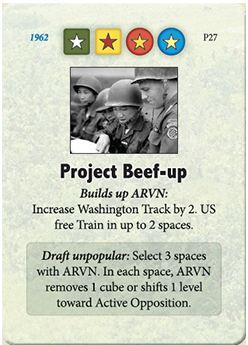The other day I received the
new Fire in the Lake expansion and after researching I discovered that it is a stage of the Vietnam War about which there is not much information. So I have decided to mix my hobby and the career I am studying, I have shuffled the deck, I have drawn a card and I have started to investigate.
This law, approved in 1959, sought to end the incipient communist insurgency and said the following:
Article 1Sentence of death, and confiscation of the whole or part of his property will be imposed on whoever commits or attempts to commit one of the following crimes with the aim of sabotage, or upon infringing upon the security of the State, or injuring the lives or property of the people:
1. Deliberate murder, food poisoning, or kidnapping.
2. Destruction, or total or partial damaging, of one of the following categories of objects by means of explosives, fire, or other means:
a. Dwelling-houses, whether inhabited or not, churches, pagodas, temples, warehouses, workshops, farms and all outbuildings belonging to private persons…
b. Public buildings, residences, offices, workshops, depots, and, in a more general way, all constructions of any kind belonging to the State, and any other property, movable or unmovable, belonging to, or controlled by the State, or which is under the system of concession, or of public management…
c. Means of transport, all kinds of vehicles…
d. Mines, with machines and equipment…
e. Weapons, military material and equipment, posts, buildings, offices, depots, workshops, and constructions of any kind relating to defence or police work…
f. Crops, draft animals and farm equipment…
g. Installations for telecommunications, postal service, broadcasting, production and distribution of electricity and water…
h. Dykes, dams, roads, railways, airfields, seaports, bridges, channels, or works relating to them;
i. Waterways, large or small, and canals…Article 3Whoever belongs to an organisation designed to help to prepare or to perpetuate crimes enumerated in Article I . . ., or takes pledges to do so, will be subject to the [same] sentences.
Article 6
Three special military courts are set up and based in Saigon, Ban Me Thuot and Hue… As the need arises, other special military courts may be set up by decree…
Article 16
The decisions of the special military court are not subject to appeal.
Article 20
All legal provisions which are contrary to the present law are hereby repealed.
Ngo Dihn Diem
Saigon, 6th May, 1959
First, let's talk about the situation in Vietnam before the implementation of the law. With the independence of Vietnam, being divided in two, the southern government was fragmented. Only having control of the urban centers. With the arrival of Ngo Dihn Diem to power, an attempt would be made to control the entire country.
At the same moment that he rose to power he had to face a series of political enemies and the threat of communism, to confront that he created the Special Commissariat for Civic Action. The cadres had to extend the influence of the government in the rural area, one of their functions was the eradication of communist cells; It was effective, but reigns of terror developed due to unscrupulous officers. This caused part of the population to align with the insurgents. By 1959, resentment had taken hold among part of the population, provoking a more reactionary response from the commissariat.
 |
| Vietnam soldiers arresting a VC member. 1963 |
Law 10/59 surpassed the excesses of previous campaigns; In the past, some suspects had been tortured and executed, but the vast majority of defendants suffered sentences ranging from several weeks in indoctrination camps to 3 years in prison.
According to experts such as David Elliot: “it denied any progress in legitimation that the southern government had achieved and made it clear that the southern regime was sustained by pure power and coercion.” Since the law was passed, most of the accused were executed on the spot; guillotines were used. This law further encouraged corruption among officials. Moderate citizens, who were on the fringes of the revolutionary movement, concluded that they had little to lose by joining the movement.
Recent investigations into the archives of the Communist Party in Hanoi have shown that this law was one of the triggers for resuming the armed conflict in the south. Another reason behind Hanoi's decision was the fear that, in the absence of bold action, the southern communists would cede the initiative to other anti-diem forces; The most notable of these movements were the political-religious organizations.
In more and more areas of the south, control passed into the hands of the revolutionaries. In June 1959, the revolutionary cadres began to act more openly, this escalated to the point of carrying out offensive actions on the outskirts of Saigon itself. By December of that same year, Communist Party members in Long An province had reorganized and rearmed several battalions, rebuilding the bases they had used in the war against the French.
In December 1960, the step was taken to form the National Liberation Front to exercise more effective control over the revolutionary movement in the south. The cycle of violence between the government and its enemies escalated dramatically in the months following the formation of the NLF.
 |
| NLF members patrolling the land adjacent to their Long An base. 1960 |
The Pentagon Papers conclude that, despite Ngo Dihn Diem's concern for rural security, the measures failed to provide adequate resources to rural police and intelligence operations. Stoning all American aid in the army while all the responsibilities of rural security in the hands of the poorly trained, poorly equipped and poorly directed units of the Civil Guard and the Self-Defense Corps. Efforts to win over the rural population were wasted by the corrupt, arrogant and authoritarian men of the commissariat.













